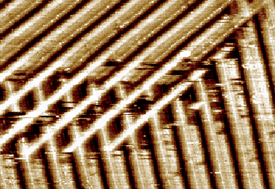Self-assembly of supramolecular wires and cross-junctions and efficient electron tunnelling across them†
Abstract
The

* Corresponding authors
a
Institut de Ciència de Materials de Barcelona (ICMAB-CSIC), Campus Universitari de Bellaterra, Cerdanyola del Vallès, Catalonia, Spain
E-mail:
amabilino@icmab.es
b
Katholieke Universiteit Leuven, Laboratory of Photochemistry and Spectroscopy, and INPAC-Institute for Nanoscale Physics and Chemistry, Celestijnenlaan 200-F, Heverlee, Belgium
E-mail:
steven.defeyter@chem.kuleuven.be
c
Service de Chimie des Matériaux Nouveaux, Université de Mons, 20, Place du Parc, Mons, Belgium
E-mail:
roberto.lazzaroni@umons.ac.be
The

 Please wait while we load your content...
Something went wrong. Try again?
Please wait while we load your content...
Something went wrong. Try again?
J. Puigmartí-Luis, A. Minoia, S. Lei, V. Geskin, B. Li, R. Lazzaroni, S. De Feyter and D. B. Amabilino, Chem. Sci., 2011, 2, 1945 DOI: 10.1039/C1SC00330E
To request permission to reproduce material from this article, please go to the Copyright Clearance Center request page.
If you are an author contributing to an RSC publication, you do not need to request permission provided correct acknowledgement is given.
If you are the author of this article, you do not need to request permission to reproduce figures and diagrams provided correct acknowledgement is given. If you want to reproduce the whole article in a third-party publication (excluding your thesis/dissertation for which permission is not required) please go to the Copyright Clearance Center request page.
Read more about how to correctly acknowledge RSC content.
 Fetching data from CrossRef.
Fetching data from CrossRef.
This may take some time to load.
Loading related content
